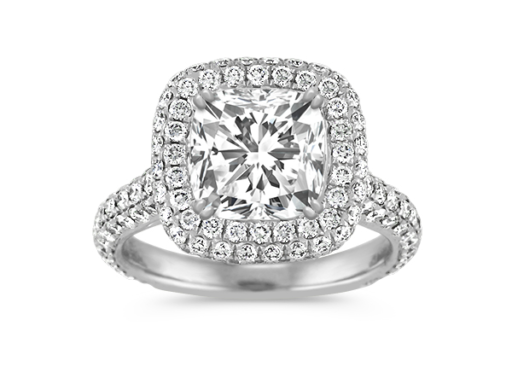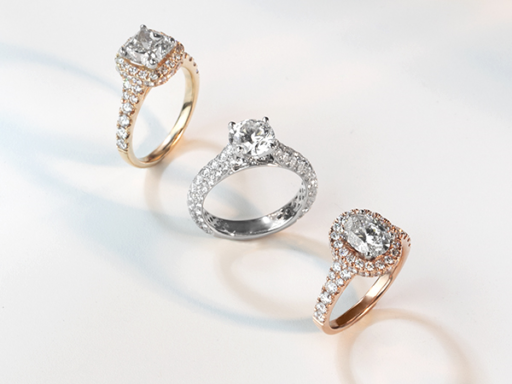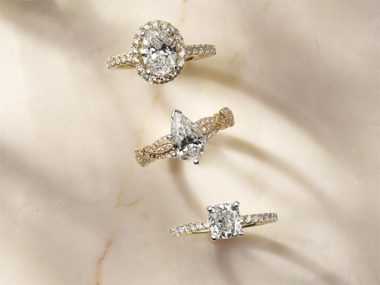If you’re in the process or even just thinking about purchasing an engagement ring, you probably have a lot of questions. One of the most common of these questions is what exactly is an engagement ring setting, and how does it affect the ring buying process? The jewelry experts at Shane Co. are here to help.
What does it mean to buy only a diamond setting?
There are two ways you can purchase a diamond ring: choose a premounted ring or choose the setting and center stone separately. Premounted refers to what you’re probably imagining when you picture an engagement ring ― a band with a diamond sitting on top, perhaps surrounded by metalwork or other smaller stones. For people who want the ultimate in ring buying simplicity, this may be the ideal option, and Shane Co. has a great selection of premounted rings to choose from.
However, this is not the only way to purchase a ring. By purchasing an engagement ring setting first, then picking out a loose diamond or other stone to display in the center, you can find the right look for her style as well as hand-pick the best diamond for your budget. Shane Co. has a tremendous selection of rings that allow our customers to create custom jewelry that perfectly fits their needs.
Benefits of buying engagement ring settings only
When you buy your engagement ring setting separate from the center stone, you’re able to create a unique engagement ring that’s guaranteed to be different from everyone else’s. Being able to hand-pick a stone for its color, cut, clarity, size and shape allows you to better take into consideration your budget in addition to your style. Plus, certain diamond shapes will look better in particular settings.
Types of settings
Engagement rings are made up of two parts: the shank (body of the ring that goes around the finger) and the head (the metal that holds the center stone in place). There are a variety of different styles of settings, each with their own unique attributes. We encourage you to take a look at some of the options available to you below, as well as talk to a certified jeweler, before making any final decisions.

Prong setting
A prong setting is the most common and popular setting for diamond engagement rings. It can accommodate a variety of different diamond cuts and shapes. The prongs act as small claws, grasping the diamond and holding it to the band. This type of setting is typically used to hold a larger center stone, though it can accommodate any number of diamond sizes.
Pros: Prong settings are so popular because they allow the diamond to be raised up and therefore disperse light more easily, allowing for the maximum amount of sparkle. They are also crafted with less metal and in less time, making them one of the more affordable diamond ring settings you can buy. They are generally quite easy to clean, as there is a lot of stone surface area visible and within reach.
Cons: Though these settings are quite secure, they may not feel as safe as other options. It’s also not a great setting to choose if you live a very active lifestyle or have to work with your hands a lot, as the prongs can snag or scratch, potentially putting the raw diamond at risk.

Halo setting
A halo setting secures the center stone underneath a rim adorned with pavé, invisible-set or channel-set diamonds. This style has become increasingly popular with celebrities because of its contemporary and unique appearance.
Pros: Very secure and will keep your center stone safe and snug, protecting it from knocking or scratching against surfaces. It can also make the center diamond appear larger because it is surrounded by smaller stones.
Cons: If your center diamond has a good color grade and you choose a colorful halo, the surrounding stones can alter the appearance and color of your diamond. In addition, lots of little diamonds means more opportunity for them to come loose and a harder fix for your jeweler.

Channel setting
A channel setting is depicted by a row of diamonds side by side, suspended by individual seats cut into each side of the channel. This setting is often used for wedding bands or for the side stones accenting the center diamond of an engagement ring. The uninterrupted stones are said to symbolize the harmonious continuity and commitment of love.
Pros: Channel settings are great for active lifestyles and health professionals because they lock each diamond securely into the band and set them flush against the ring, virtually eliminating the opportunity for snagging or catching. Lots of diamonds also means lots of sparkle!
Cons: Because of the excess metal and labor, channel settings can be more expensive than their counterparts. They are also not recommended for fragile gems and can be difficult to resize later on.

Bezel setting
In a bezel setting, the metal is formed around the shape of the diamond so that the top of the stone sits flush to the perimeter of the setting. You can get a full bezel, which encircles the entire stone, or a partial bezel, which holds two sides of the stone but leaves openings on the other two.
Pros: Perfect for an active lifestyle and health professionals, this ring offers a clean, modern look. It can also easily conceal nicks or chips on the diamond girdle. A white gold bezel setting can make the center diamond appear larger.
Cons: It may be more expensive because of the extra metal and labor, and it can conceal up to 10% of the diamond (though a well-cut diamond’s light enters and exits primarily through the top of the diamond, which will remain uncovered).

Three-stone setting
With a three-stone setting, the center diamond is flanked by two other stones. This is a classic engagement ring style we’re sure you’ve seen before.
Pros: This setting offers the opportunity for more customization. For example, you can choose a ring that has sapphires or rubies as the side stones. When paired properly, the two side stones can add a lot more sparkle and personality.
Cons: Larger diamonds on the sides can make the center stone appear smaller. This setting also requires more cleaning and maintenance than some of the other options.

Cathedral setting
A cathedral setting uses arches of metal to hold the diamond high above the band. It adds height and a vintage feel to the ring.
Pros: Adding height can make the center diamond appear larger. It’s also a very elegant style and allows for more detail near the underside of the diamond, such as filigree metalwork or pavé diamonds. It securely holds and highlights the center stone.
Cons: This setting can look a bit more cluttered than others. It’s also more difficult to clean and may snag on clothes or furniture.

Pavé and micro-pavé setting
This setting gets its name from the French word for “paved” and uses tiny beads or prongs from surrounding metal to hold tiny diamonds into place. When using the smallest version of these diamonds, it’s called a micro-pavé.
Pros: Pavé settings provide lots of sparkly flair and flash and can be found on all ring styles from contemporary to vintage in style. It’s a smooth surface that can work with active lifestyles.
Cons: It carries the risk of diamonds falling out, particularly because they’re so small. This setting is also not recommended for fragile gems.
How to make your diamond ring look better
Did you know that choosing the right setting can actually make your center stone look bigger and better? Whether you’ve chosen a 1.00-carat diamond ring or something much larger, taking the diamond clarity, cut, color and shape into consideration can vastly improve the stone’s appearance. Here are some tips to make your diamond appear bigger and brighter in your new ring:
- Fewer prongs = more room to sparkle.
- White gold bezel settings will surround a colorless diamond and trick the eye into thinking it’s larger than it is.
- Halo settings use surrounding smaller diamonds to create the appearance of a larger stone.
- A thin band means your diamond is the center of attention.
- 3-stone settings with small side stones can complement your diamond’s natural beauty.
- Yellow gold and rose gold settings can cover up the yellowish tint in a diamond that’s lower on the color scale.
- Shiny metals reflect light and make your center stone have more sparkle.
- Try out an alternate center stone shape, like an emerald cut or princess cut diamond, instead of traditional round for a unique look.
- Keep it clean: A clean diamond is always a stunner.
You can shop all of Shane Co.’s engagement ring settings before picking out a gorgeous center diamond or gemstone to complete your look. We’re proud to offer the highest-quality diamonds in every GIA grade, as well as over a thousand exclusive engagement ring styles. Get the best value for your budget at Shane Co.





